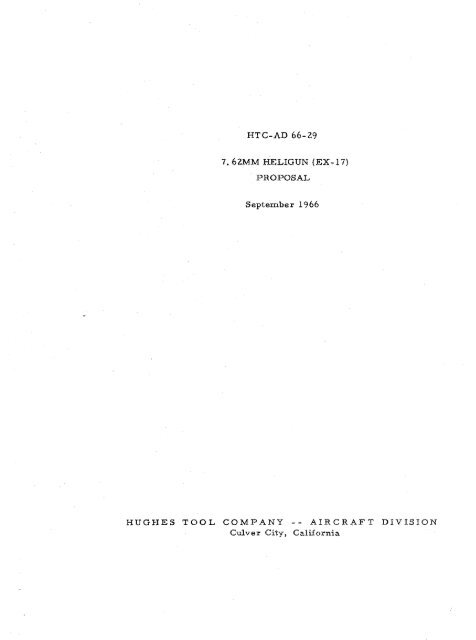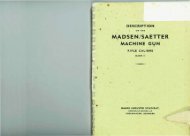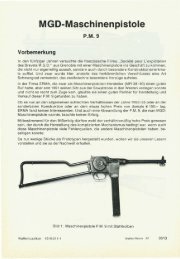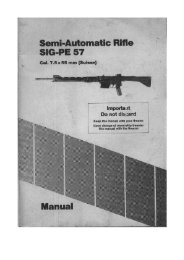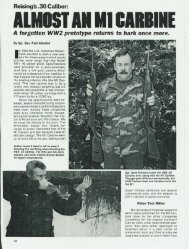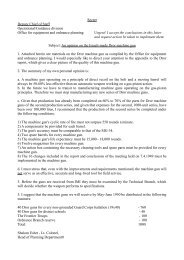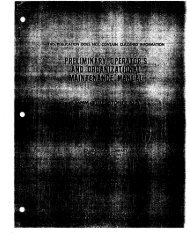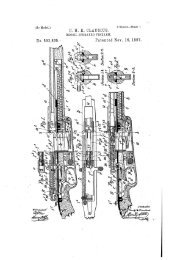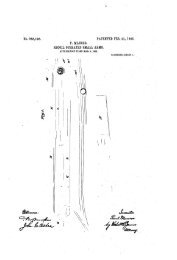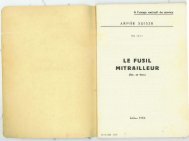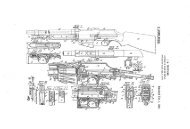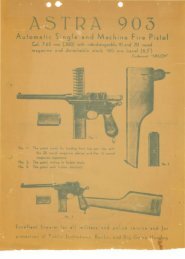Heligun EX17.pdf - Forgotten Weapons
Heligun EX17.pdf - Forgotten Weapons
Heligun EX17.pdf - Forgotten Weapons
You also want an ePaper? Increase the reach of your titles
YUMPU automatically turns print PDFs into web optimized ePapers that Google loves.
HTC-AD 66-29<br />
7. 62MM HELl GUN (EX-17)<br />
PROPOSAL<br />
September 1966<br />
HUGHES TOOL COMPANY -- AIRCRAFT DIVISION<br />
Culver City, California
HTC-AD 66-29
Figure<br />
1<br />
2<br />
3<br />
4<br />
5<br />
6<br />
7<br />
8<br />
9<br />
10<br />
11<br />
12<br />
13<br />
14<br />
15<br />
16<br />
LIST OF ILLUSTRATIONS<br />
Frontispiece: Seven Preproduction <strong>Heligun</strong>s (EX-17).<br />
Mission Success - Two <strong>Heligun</strong>s (EX-17) Versus<br />
Single Gun (XM-134) .•••..•...<br />
Advantages of <strong>Heligun</strong> Installation<br />
Helicopter Accuracy ..•..<br />
Kill Ratio for Two <strong>Heligun</strong>s Versus One XM-134 Gun.<br />
Weights and Drag Areas<br />
Comparison of Frontal Area of <strong>Heligun</strong> and XM-134<br />
on OH-6A Helicopter ........... .<br />
Rounds Fired Versus Funding Period<br />
<strong>Heligun</strong> (EX-17) Firing Summary<br />
<strong>Heligun</strong> (EX -1 7) ....•..•....<br />
<strong>Heligun</strong> on OH-6A Helicopter Kit<br />
<strong>Heligun</strong> on Test Stand<br />
Firing Analysis .....<br />
Gun Stoppage Analysis<br />
Safe and Arm Mechanism<br />
<strong>Heligun</strong>, Assembly Drawing<br />
<strong>Heligun</strong> (EX-1 7) Proposed Development Program<br />
'•<br />
HTC-AD 66-29<br />
Page<br />
ii<br />
4<br />
5<br />
7<br />
8<br />
9<br />
10<br />
15<br />
15<br />
16<br />
1.7<br />
18<br />
19<br />
21<br />
23<br />
24<br />
28<br />
iv
INTRODUCTION<br />
7. 62MM EX-17 HELIGUN<br />
HTG-AD 66-29<br />
This proposal summarizes the status of the EX-17 <strong>Heligun</strong> and outlines<br />
a program for continued development.<br />
The <strong>Heligun</strong> (Frontispiece) is at its mid-development phase. Starting in<br />
1963, a prototype was designed and fabricated with HTC-AD funds and<br />
fired for 75, 000 rounds. Burst lengths of 450 rounds and reliability o£<br />
1500 rounds to a stoppage were demonstrated.<br />
This work was followed by the fabrication of eight preproduction weapons<br />
for the Naval <strong>Weapons</strong> Laboratory - Dahlgren in 1965 on Contract<br />
Nl78-8795. Navy funding requested for development was. not available,<br />
so engineering of the preproduction model was again continued on HTC-AD<br />
funds, This work included the firing of 125, 000 rounds on the Navy guns<br />
and resulted in improvement of the preproduction model and increased<br />
reliability,<br />
A one-year Scope of Work is included herein to continue the development<br />
of the <strong>Heligun</strong>, using the preproduction weapons to fire an additional<br />
500, 000 rounds for further improvement of reliability to 5000 rounds per<br />
stoppage. A second year program, with additional hardware, is proposed<br />
to increase the reliability to 10,000 rounds per stoppage through the<br />
firing of 1, 200,000 rounds, Also included is the development of accessory<br />
items, and support for aircraft installations such as the OV 1 OA.<br />
l
HELIGUN FEATURES<br />
HTC-AD 66-29<br />
The performance of the <strong>Heligun</strong>, including flight demonstration in the<br />
OH-6A helicopter, has proven that it is a major advance in state-of-the<br />
art in light machine guns. It weighs 30 pounds, and fires the standard<br />
7. 62mm NATO round with M-13 link at 6000 shots per minute. The gun<br />
is self-powered with recoil and gun gas energy, and employs the same<br />
Marquardt principle as proven in the HTC-AD-developed Navy 20mm<br />
Mk 11 gun. As in its 20mm counterpart, the <strong>Heligun</strong> delivers more<br />
firepower per pound than any gun in its caliber, is easy and light to install,<br />
and has a small frontal area for low drag and inherently low trunnion<br />
reaction as a result of recoil momentum cancellation. It has unique<br />
safety features, simple quick-disconnect maintenance, and low cost.<br />
Being self-powered, it can also be used off of the aircraft or in places<br />
where power is not available.<br />
The instant start-stop feature of the <strong>Heligun</strong> makes it ideal where short<br />
bursts are required for maximum accuracy or ammunition conservation.<br />
The reliability achieved to date is exceptional, considering the limited<br />
funding available for concentration on this phase of the development. The<br />
results confirm the design concepts of the gun and are evidence that its<br />
simplicity will produce high reliability. Problem areas have been defined<br />
and involve minor design change for solution (Appendix A).<br />
Comparison with the XM-134 Minigun is made in this report, since this<br />
is the existing high-rate-of-fire Service weapon. HTC-AD is currently<br />
designing and will produce the XM-27El armament system employing the<br />
XM-134 gun for the helicopter, and is conducting extensive gun firing of<br />
it at the Culver City facility.<br />
2
WEIGHT<br />
HTC-AD 66-29<br />
One of the advantages of the <strong>Heligun</strong> over the XM-134 Minigun is weight.<br />
The <strong>Heligun</strong> weighs approximately one-half as much, not counting the<br />
external power requirement of the XM-134. The double firepower per pound<br />
of the <strong>Heligun</strong> makes it an efficient airborne weapon, particularly for air-<br />
craft with advanced performance requirements such as the OVl OA (Appendix F)<br />
and the OH- 6A helicopter (Appendix E).<br />
Future fixed- and rotary-wing aircraft can be expected to have even more<br />
stringent performance and weight requirements. This trend is a natural<br />
evolution and very evident in recent years as aircraft are called upon for<br />
greater flexibility on missions and more universal use between Services.<br />
One aspect of the weight difference is the freedom to use two <strong>Heligun</strong>s instead<br />
of one XM-134 for greater mission reliability. With equal quantity of ammuni<br />
tion, two <strong>Heligun</strong>s can be installed for the same weight as one Minigun. The<br />
available redundancy increases reliability by a factor of ten. For example, it<br />
provides 99 percent mission success with a 10, ODD-rounds-per-stoppage gun<br />
that would otherwise require an unattainable 120,000 rounds per stoppage<br />
from a single XM-134 gun system (Figure 1).<br />
Alternately, as a single gun-system, the lower <strong>Heligun</strong> weight will allow<br />
increases in aircraft performance (250-ft increase in hover ceiling on a hot<br />
day or 6-percent increase in fuel payload in OH- 6A helicopter), or increase<br />
of 415 rounds of additional 7. 62mm ammunition (33-percent increase on<br />
OVIOA) (Figure 2).<br />
EFFECTIVENESS<br />
Instantaneous high rate of fire and the associated constant recoil forces as<br />
provided by the <strong>Heligun</strong> simplify pilot training and provide more hits per round<br />
fired. The greater accuracy is obtained when the maximum number of rounds<br />
3
A SINGLE HELIGUN INSTALLATION CAN ALLOW<br />
4 GALLONS MORE FUEL<br />
OR<br />
415 ROUNDS MORE AMMUNITION<br />
OR<br />
25 POUNDS LESS WEIGHT<br />
Figure 2. Advantages of <strong>Heligun</strong> Installation<br />
HTC-AD 66 29<br />
5
0.5 J<br />
TIME- SEC<br />
Figure 3. Helicopter Accuracy<br />
HTC-AD 66-29<br />
1.5 2<br />
7
5<br />
4<br />
l<br />
0<br />
"" "'-.<br />
0 0.5 1.0 1.5 2. 0<br />
BURST DURATION- SEC<br />
HTC-AD 66-29<br />
Figure 4. Kill Ratio for Two <strong>Heligun</strong>s Versus One XM-134 Gun<br />
8
HTC-AD 66-29<br />
Figure 6. Comparison of Frontal Area of <strong>Heligun</strong> and XM-134<br />
on OH-6A Helicopter<br />
10
HTC-AD 66-29<br />
The <strong>Heligun</strong> utilizes dual ammunition belts to reduce belt velocity. This<br />
feature reduces belt loads fourfold, It also provides more flexibility for<br />
installation by allowing belt storage in two side-by-side ammunition containers<br />
without a crossover device. The ammunition feeder is integral with the gun<br />
and positively driven. The feeder pull capacity eliminates the need for<br />
ammunition boosters for any normal installation.<br />
Gun mounting can be accomplished without conce1·n about distance from an<br />
electrical source or the addition of storage batteries. Removal and use of<br />
the <strong>Heligun</strong> from a disabled vehicle would be practical. Application of this<br />
high firepower to ground vehicle and boats offers additional potential. A<br />
four- gun pack of <strong>Heligun</strong>s at 120 pounds could provide a dense firepower<br />
of 24, 000 shots per minute for a ground-to-air weapon and yet be simple<br />
and light enough for manual swivel on a vehicle mount.<br />
SAFETY<br />
The <strong>Heligun</strong> offers safety advantages similar to those of the Mk 11 gun-<br />
positive prevention of double feed and protection against inadvertent firing,<br />
hangfire, and cookoff damage.<br />
NEED<br />
The Vietnam conflict has proven that guns are still a most versatile and<br />
needed weapon. Since guns are also one of the longest leadtime items of<br />
military hardware, it follows that farsighted gun development is required,,<br />
Viewed within the time frame of gun mechanisms, the Marquardt principle<br />
of the <strong>Heligun</strong> is new. It was invented approximately 20 years ago, compared<br />
with 100 years ago for the Gatling gun.<br />
ll
HTC-AD 66-29<br />
Being new, the growth possibilities of this gun cycle are still being explored.<br />
The <strong>Heligun</strong> is one such growth example, generating from the basic 20mm<br />
gun, the Mk 11. Additional growth possibilities exist in other calibers,<br />
For example, a 5. 56mm caliber <strong>Heligun</strong> would weigh 15 pounds and fire<br />
8000 shots per minute.<br />
An analogy to the <strong>Heligun</strong> may be found in engine development. As the<br />
power requirements for aircraft engines went up, the reciprocating engine<br />
was stretched to its limits but could not meet the need. The turbine<br />
engine, with a new principle, did. By comparison, the <strong>Heligun</strong> dispenses<br />
with all mechanism traditionally used to ram, lock, extract, and eject the<br />
ammunition -- the parts that give trouble in a gun (Gun Cycle Description,<br />
Appendix B, pp 1 - 6). This stroke of simplification provides a breakthrough<br />
similar to that of the turbine engine,<br />
The armament for the OH-6A helicopter is a case in point. The utmost<br />
care in weight reduction resulted in a 115-pound unit with the XM-134 gun.<br />
Only by use of an advanced self-powered weapon such as the <strong>Heligun</strong> can<br />
the more desirable weight of 85 pounds be achieved,<br />
The <strong>Heligun</strong> has growth potential.<br />
12
CONVENTIONAL GUN FUTURE<br />
HTC-AD 66-29<br />
Experience has shown that cbntinued improvement of the conventional<br />
7. 62mm gun will be a good investment. This projectile size has survived<br />
for nearly a century because it has an attractive balance of weight, cost,<br />
lethality, accuracy, and range. Unlike lighter projectiles, it is not<br />
easily deflected by ground cover, can be used at reasonable range from<br />
aircraft, and will penetrate up to 1/2 inch of steel. Its existence forces<br />
the use of compromising armor and tactics.<br />
Design of the 7. 62mm cartridge itself is also unlikely to be obsoleted by<br />
caseless ammunition or liquid propellants. In addition to providing a strong<br />
package for handling, the case does its most important work during firing<br />
by sealing the 50, 000-psi chamber pressure and discharging the intense<br />
heat of combustion each gun cycle.<br />
13
DEVELOPMENT STATUS<br />
HTC-AD 66-29<br />
Testing of the <strong>Heligun</strong> has been under way since 1963, with approximately<br />
200,000 rounds fired to date, as shown in Figure 7, This firing is the total<br />
of 75, 000 rounds on the prototype <strong>Heligun</strong> and 125, 000 rounds fired on the<br />
eight preproduction Navy guns (Figure 8).<br />
The preproduction guns (Figures 9 through 11) were fabricated under Contract<br />
Nl78-8795 in accordance with Specification WS-5678 (Appendix C). These<br />
weapons, including spare parts, are available for delivery and will meet the<br />
contractual requirements for performance. They have not been delivered,<br />
however, because it became apparent that the reliability achievable within<br />
company funding is not sufficient for the originally intended evaluation in<br />
the TAT 101 turret, A reliability of 1000 rounds per stoppage has been the<br />
minimum considered usable by the Technical Project Officer at the Naval<br />
<strong>Weapons</strong> Laboratory.<br />
Such reliability is repeatedly achieved in spans of firing with the <strong>Heligun</strong>,<br />
but it cannot be demonstrated on the average. An example of current<br />
reliability is shown in Figure 12, Results are charted for the last 12, 000<br />
rounds fired with Serial No, 5 gun, During this span, the peak reliability<br />
was 1500 rounds to a stoppage a.nd the average was 660 rounds per stoppage,<br />
Five spans of more than 1000 rounds to a stoppage were fired.<br />
In this test, the firing schedule was 100-round bursts (one-second) with<br />
three-minute pause between bursts (no forced cooling), and 15-minute<br />
pause after each fourth burst. This schedule was followed until fireout<br />
14
lTC-AD 66-29
Figure 10. <strong>Heligun</strong> on OH-6A Helicopter Kit<br />
(±20° Elevation Control)<br />
HTC-AD 66-29<br />
17
HTC-AD 66-29<br />
18
HTC-AD 66-29<br />
of the 1500-round ammunition container. Maintenance and parts replacement<br />
was held to a minimum, since the purpose of the test was to simulate field<br />
conditions. In the above test, the gun stopped normally in 108 out of 126<br />
bursts ( 85 percent).<br />
The causes and occurrence point of the stoppages are charted at the bottom<br />
of Figure 12. Six causes are shown, and these are typical for all the pre<br />
production guns. A discussion of these problems is contained in Appendix A.<br />
Stoppage description for 35, 000 rounds fired on several <strong>Heligun</strong>s is shown<br />
in Figure 13.<br />
Significant progress in the <strong>Heligun</strong> development has been made as a result<br />
of the preproduction program, as follows:<br />
1. Experimental drawings were upgraded to production quality<br />
2. Eight guns were built on budget, demonstrating producibility<br />
3. An interim field manual was prepared for the <strong>Heligun</strong> (EX-17)<br />
(Appendix B)<br />
4. Hold-forward spring was incorporated to improve first-fire<br />
reliability<br />
5. Feed sprocket was positioned for better belt and preram control<br />
6. Ram cycle was improved<br />
7. Anti bounce spring was redesigned for longer life<br />
8. Revolver chamber configuration was refined<br />
9. Cylinder bearing was modified to eliminate metal-to-metal<br />
galling<br />
10. Flight tests were successfully conducted (Appendix E)<br />
11. Prototype of an electric remote safe-and-arm device was designed<br />
and tested<br />
12. Breadboard of cartridge charger was tested<br />
20
Miscellaneous<br />
Ruptured Case<br />
Pneumatic Tube<br />
Cycle<br />
Ram<br />
Ignition<br />
Summary of Stoppage Data<br />
on Six <strong>Weapons</strong> and 35,000<br />
Rounds<br />
PERCENT OF STOPPAGES<br />
Figure J 3. Gun Stoppage Analysis<br />
HTC-AD 66-29<br />
21
HTC-AD 66-29<br />
The remote safe-and-arm device (Figure 14) requires only one-half ampere<br />
to cock, arm, safe, or clear the weapon, In final form, it will weigh less<br />
than one pound, This device is simple and offers electric remote control,<br />
as desired in a <strong>Heligun</strong> installation.<br />
The cartridge-actuated charger has been designed and tested with a bread<br />
board mockup to prove its feasibility. This charger utilizes seven standard<br />
7. 62mm cartridges in such a fashion as to keep each bullet captive when<br />
individual cartridges are fired. The hot gas from a single captive bullet<br />
cartridge is admitted to the <strong>Heligun</strong> gas system to cycle the weapon, ram<br />
live ammunition, and eject previously fired cases. This device permits<br />
inflight arm, safe, and clear functions as well as recharging after clearing<br />
and clearing defective ammunition,<br />
The objective of the <strong>Heligun</strong> development program is to achieve the weapon<br />
characteristics as specified in WS 5679 (Appendix D). These characteristics<br />
(reliability of 20,000 shots per stoppage, burst length of 750 rounds, accuracy<br />
of four mils, 30-pound weight, 100, 000-round weapon life, and 15, 000-round<br />
barrel life) are proven to be achievable by the work to date.<br />
The resulting gun will fill the need for an advanced weapon useful for future<br />
decades.<br />
22
HTC-AD 66-29<br />
23
PROPOSED HELIGUN DEVELOPMENT<br />
HTC-AD 66-29<br />
<strong>Heligun</strong> {EX-17) development to meet the requirements of specification<br />
WS 5679 can be achieved by an engineering and test effort of the type that<br />
permitted the successful development of the Mk 11 gun at the Hughes Tool<br />
Company. Key ingredients for success are adequate hardware and an<br />
intensive test program, as outlined under Scope of Work.<br />
SCOPE OF WORK<br />
FIRST YEAR<br />
The contractor shall, during a 12-month program, develop and refine the<br />
operation of the EX-17 (<strong>Heligun</strong>), providing the necessary fabrication,<br />
test, study, and demonstration as included in the specific items listed.<br />
Item 1, Engineering<br />
Perform the necessary engineering and design effort to develop the EX-17<br />
to a reliability of 2000 to 5000 rounds per stoppage,<br />
Item 2 .. Test<br />
Utilizing the weapons fabricated under Contract N178-8795, retrofitting as<br />
required, conduct firing tests to support Item 1 (500, 000 rounds).<br />
25
Item 3. Application<br />
HTC-AD 66-29<br />
Perform necessary engineering, testing, and fabrication to demonstrate<br />
weapon application to mounts for HUI, LOH, COIN, or other vehicles,<br />
including TAT 101 turret, as available (100, 000 rounds).<br />
Item 4. Demonstration<br />
Provide field demonstration and technical support as required, not to exceed<br />
1000 man-hours.<br />
Item 5, Fabricate<br />
Fabricate 15 weapons and spares, incorporating the developments resulting<br />
from Items 1 through 4 above, for future evaluation and the second-year<br />
program.<br />
SECOND YEAR<br />
The contractor shall, during the second 12-month program, continue<br />
development of the EX-17 (<strong>Heligun</strong>) with the objective of increasing<br />
reliability of 5000 to 10, 000 rounds per stoppage. The following specific<br />
items are cons ide red part of this effort.<br />
Item 1, Engineering<br />
Continue enginee'dng development and intensive testing with concurrent data<br />
feedback. Incorporate required design modifications in order to achieve the<br />
desired reliability of 5000 to 10,000 rounds per stoppage.<br />
Item 2. Test<br />
Utilize the weapons fabricated during the first year (Item 5) for further test<br />
analysis and development (1, 200,000 rounds).<br />
26
Item 3. Application<br />
HTC-AD 66-29<br />
Perform necessary engineering, testing, and fabrication for additional<br />
weapons application (250, 000 rounds).<br />
Item 4, Demonstration<br />
Provide field demonstration and technical support not to exceed 1000<br />
man-hours.<br />
Item 5. Fabricate<br />
Fabricate 20 weapons and spares incorporating engineering improvements<br />
developed under Items 1 through 4 above. These guns are to be available<br />
for additional field evaluation, A cartridge-actuated charger will be<br />
developed and seven units fabricated.<br />
27
N<br />
(X)<br />
Engineering and Design Study<br />
Alter and Retrofit {2 guns)<br />
Test<br />
Progress Demonstration<br />
Engineering and Design Improvements<br />
Alter and Retrofit Remaining Guns<br />
Test<br />
Progress Demonstration<br />
Weapon Application Effort<br />
Field Demonstration and Support<br />
Engineering Additional Guns ( 1 5)<br />
Fabricate 15 Guns<br />
Test and Improve<br />
Progress Demonstration<br />
Engineering and Development<br />
Weapon Application Effort<br />
Field Demonstration and Support<br />
Engineering and Development<br />
Progress Den10nstration<br />
Fabricate 20 Guns<br />
Test<br />
Progress Demonstration<br />
Figure 16. <strong>Heligun</strong> (EX-17) Development Program<br />
..., ::r::<br />
()<br />
> '<br />
tj<br />
GUN CHARACTERISTICS<br />
SUMMARY OF HELIGUN (EX-17) FEATURES<br />
l, 6000 shots per minute<br />
2. Self-powered<br />
HTC-AD 66-29<br />
3. Full firing rate obtained immediately upon initiation of firing<br />
4. Small, light, and simple (30 pounds)<br />
5. Dual belt fed, resulting in low belt velocities and large margins<br />
of belt strength<br />
6. Does not expel unfired ammunition<br />
7. Alternate lower rate of fire possible<br />
8. Positive case and link ejection<br />
MAJOR SAFETY FEATURES<br />
I. No possibility of double feed<br />
2, No possibility of hangfire damage to gun or aircraft<br />
3. No possibility of cookoff damage to gun or aircraft<br />
4. Positive clearing at pilot option (no rounds in revolver)<br />
LOW PRODUCTION COST<br />
l. EstLmate cost to be the same as that of the.M-60 machine gun<br />
2. Only 69 different gun parts<br />
29
EFFECTIVENESS<br />
l. More hits per burst as a result of instant full rate of fire<br />
(greater accuracy, higher average rate)<br />
AIRCRAFT COMPATIBILITY<br />
HTC-AD 66-29<br />
l. Minimum installed weight in aircraft (self-powered 30-lb gun)<br />
2. Recoil cancellation oLMarquardt cycle reduces peak loads to<br />
structure<br />
3. Receiver is stationary, so installation and feed system does not<br />
have to accommodate movement on recoil adapters<br />
4. Belt feeding provides light, simple, and inexpensive feed system<br />
(ammunition boost system not required)<br />
5. Dual belt feeding allows use of more conveniently sized ammunition<br />
boxes<br />
6. Reciprocating barrels allow simple blast control<br />
7. Positive case and link ejection<br />
8. Small frontal area and volume permit thin airfoil and reduced<br />
drag<br />
MAINTENANCE AND TRAINING<br />
1. Instant full rate of fire provides maximum accuracy with minimum<br />
pilot training<br />
2. Easi
FIELD SUITABILITY<br />
GROWTH<br />
HTC-AD 66-29<br />
1. Simplicity and ruggedness of parts suited to COIN environment<br />
2. No external power required for test firing<br />
3. Field strips in less than one minute with no tools into 14 parts -<br />
each large enough for handling with gloved hands<br />
4. Self-powered, <strong>Heligun</strong> can also be utilized in ground vehicles<br />
and small craft, and for perimeter defense<br />
5. Uses standard M-13 linked ammunition-- same as ground forces<br />
1. Multiple gun installations are easier, with smaller size, lower<br />
weight, and zero gun power requirement<br />
3 1
APPENDIX A<br />
FURTHER HELIGUN DEVELOPMENT NEEDS<br />
HTC-AD 66-29<br />
A-J
IGNITION<br />
FURTHER DEVELOPMENT NEEDS<br />
HTC-AD 66-29<br />
The percussion primers of the 7. 67mm ammunition are fired by mechanical<br />
impact on the lower barrel firing pin and hot gas pneumatic impact on the<br />
upper barrel firing pin. Ignition stoppages fall into two main categories,<br />
because of the differences in the firing mechanisms employed. The reli<br />
ability of the ammunition itself has proven to be excellent, and the solution<br />
to ignition stoppages will be found in increased reliability of the weapon<br />
firing mechanisms.<br />
Lower barrel (first-fire) ignition stoppages are relatively rare and are<br />
caused by either:<br />
L Low counterrecoil velocity, or<br />
2. Unusual hammer excursions<br />
The first cause will be controlled by improved parts life and cycling<br />
o£ the recoiling parts and revolver, as discussed in a later paragraph.<br />
Item 2 requires investigation of causes and their subsequent elimination.<br />
Upper barrel (last-fire) ignition problems are caused by temperature and<br />
fouling effects ase.ociated with the gun gas firing mechanisms. Changes in<br />
shape and fit of parts will eliminate this problem. Currently, one-third<br />
of the stoppages are of the ignition type.<br />
A-2
RAMMING<br />
HTC-AD 66-29<br />
Ramming in the <strong>Heligun</strong> is obtained without moving parts by directing gun<br />
gas pressure on rounds in the feeder. Occasionally, a cartridge case<br />
is misaligned during ramming, causing a gun stoppage. Basic alignment<br />
of the rounds is provided by the positive gear-driven feeder sprockets.<br />
Additional study of allowable ram clearances and tolerances is required to<br />
prevent the occasional stoppage. Currently, one-fifth of the stoppages are<br />
of the ram type. They occur periodically in a particular gun mechanism,<br />
indicating excessive tolerance buildup. Marks on a misrammed round<br />
are shown in Figure A-1.<br />
CHAMBER<br />
The revolver chamber shape had three requirements: it must (1) arrest<br />
the rammed cartridge without allowing debulleting, (2) adequately support<br />
the cartridge during firing, and (3) permit easy extraction of the fired<br />
case. The present chamber meets the first and third requirements very<br />
well, but is marginal in the second. An occasional ruptured cartridge<br />
case indicates need of further testing to establish the optimum chamber<br />
shape. Ruptured cases currently account for 5 percent of the stoppages.<br />
ANTIBOUNCE SPRING<br />
During the ramming cycle, the cartridge is propelled through the anti<br />
bounce spring (Figure A- 2). When the head of the cartridge clears the<br />
forward end of the spring, the finger-like projections move inward to<br />
prevent the cartridge from bouncing out of the cylinder chamber. Part<br />
breakage and failure of the finger projections to close quickly enough<br />
have caused gun malfunctions. Improved design of the antibounce spring<br />
is indicated, as is a possible change in material. Eight percent of the<br />
stoppages are caused by the antibounce springs.<br />
A-3
Figure A-1. Misrammed Round<br />
HTC-AD 66-29<br />
A-4
HTC-AD 66-29<br />
A-5
CYCLING AND CAM SHAPE<br />
HTC-AD 66-29<br />
An improved earn shape on the revolver is needed to increase the gun<br />
cycle reliability in rotation and return to battery. An increase in breech<br />
travel by 1 I 8 inch will allow the use of a cylindrical cam with a substan<br />
tially reduced pressure angle. The improved cam shape will permit a<br />
reduction in the recoil spring load and the amount of gun gas boost. The<br />
resulting reduction in gun cycle loads will give better operation on<br />
resilient mounts. High loads between the cam surfaces (Figure A-3) and<br />
the cam followers have caused wear of the metal (Figure A-4). The pro<br />
posed cam shape will have the same proportions as the proven cam in the<br />
Mk 11 gun. Gun cycling difficulties now account for 16 percent of the<br />
stoppages.<br />
PNEUMA TIC TUBE<br />
The pneumatic tube transports gun gas from the first-fire barrel to the<br />
last-fire, gas- actuated firing pin. Changes in the amount of powder<br />
residue or fouling have been recently noted, following three- to four<br />
thousand-round firi
Figure A 4. Cam Follower<br />
HTC-AD 66-29<br />
A-8
APPENDIX B<br />
INTERIM HELIGUN MANUAL
HTC-AD 66-21<br />
INTERIM HELIGUN MANUAL<br />
August 1966<br />
HUGHES TOOL COMPANY -AIRCRAFT DIVISION<br />
Culver City, California
iii<br />
HTC-AD 66-21
TABLE OF CONTENTS<br />
INTRODUCTION .........•....<br />
1. Normal Service (Field Stripping)<br />
1.1 Disassembly<br />
1 . 2 Cleaning<br />
1.3 Inspection<br />
1.4 Lubrication<br />
1. 5 Assembly<br />
2. Overhaul .....<br />
3.<br />
2. 1 Disassembly<br />
2, 2 Cleaning .<br />
2, 3 Inspection<br />
2. 4 Lubrication.<br />
2. 5 Assembly .<br />
Troubleshooting<br />
iv<br />
HTC-AD 66-Zl<br />
Page<br />
8<br />
8<br />
11<br />
12<br />
12<br />
12<br />
14<br />
14<br />
20<br />
21<br />
23<br />
23<br />
25
INTRODUCTION<br />
HTC-AD 66-21<br />
The <strong>Heligun</strong> is a light, self-powered, high-rate- of-fire weapon chambered<br />
for the 7. 62-rrun NATO cartridge. The maximum rate of fire is in excess<br />
of 6000 shots per minute, Weighing approximately thirty pounds, the gun<br />
provides four to ten times the fire power a£ other self-powered weapons,<br />
In comparison with other high-rate-of-fire guns, it provides the simplicity<br />
an? safety of a self-powered gun at less than half the system weight and at<br />
even greater reductions in cost and complexity.<br />
The gun is belt-fed, using the standard M13 link, Dual belts are used to<br />
increase the 1nargin of safety of the link and to facilitate ammunition box<br />
installation, No ammunition booster is required in normal systems.<br />
It should be noted that the <strong>Heligun</strong>, unlike externally-powered weapons,<br />
achieves its full rate of fire instantaneously, providing a major accuracy<br />
advantage,<br />
Gun Function<br />
The <strong>Heligun</strong> operates on the Marquardt cycle, using a combination of<br />
recoil and gun gas energy for power, No external power is required for<br />
operation.<br />
Starting<br />
When the trigger is pulled, the auxiliary firing pin is unseared and strikes<br />
the hammer, firing the cartridge in line with the lower barrel,<br />
Rarruning and Ejecting<br />
As the bullet passes the ram port approximately five inches down the barrel,<br />
gun gas is permitted to flow into the ram system. This gas flows through<br />
1
HTC-AD 66-21<br />
the gas manifold. Here it is divided, part flowing into the eject system,<br />
ejecting any cartridge cases in the chambers in line with the eject ports,<br />
The balance of the gas flows through the drive shaft to the distributor<br />
section, where it is split and flows to the appropriate sprocket cups. As<br />
the pressure builds up in the sprocket cups, the cartridges therein are<br />
rammed into the chambers in line with the ram ports. Multifingered<br />
antibounce springs· prevent the cartridges from bouncing out of the<br />
chambers.<br />
Pneumatic Firing System<br />
As the bullet in the lower barrel passes the firing system port, gas is<br />
admitted to the passage in the booster housing. It flows through the<br />
breech tube and the breech into the area behind the pneumatic (upper)<br />
firing pin. As the pressure builds up, the pin is driven forward against<br />
the spring and fires the cartridge in line with the upper barrel,<br />
Recoil<br />
As the two bullets travel through their respective barrels, the impulse<br />
is transmitted to the recoiling portion of the gun (Figure 1), This<br />
portion comprises the cylinder, breech, barrels, and barrel locks. As<br />
the cylinder recoils, the cam follower in the receiver cover drives the<br />
cylinder in rotation, converting the recoil energy into rotational energy,<br />
When the action reaches the full recoil point, the recoil is stopped and the<br />
peak rotational speed is achieved, At this point, the cam follower reaches<br />
the counte·r recoil part of the cam and the rotational energy is converted<br />
to counter recoil force, causing the action to return to battery. As the<br />
battery position is reached, the slope at the end of the cam lifts the cam<br />
follower out of the cam. This action transmitted by the rocker arm<br />
2
3<br />
HTC-AD 66-21
HTC-AD 66-21<br />
engages the other cam follower in the next cam groove, in preparation for<br />
the next gun cycle (Figure 2).<br />
As the breech recoils, it pushes the auxiliary firing pin to the rear to a<br />
point beyond where the sear engages, leaving it cocked until needed to start<br />
the next burst,<br />
Recoil Boost<br />
As the bullet travels through the upper barrel, it passes the recoil boost<br />
port, admitting gun gas to the recoil boost cylinders surrounding the two<br />
barrels, Here the gas pressure acts upon piston shoulders on the barrels<br />
to augment the normal recoil energy. The level of boost used can be<br />
varied by changes of port diameter to adjust rate of fire or compensate<br />
for variations in mount rigidity.<br />
Automatic Fire<br />
If the trigger is still depressed when the recoiling part of the gun approaches<br />
battery, the hamme:r tang strikes the firing cam and fires the newly rammed<br />
cartridge that was moved into alignment with the barrel during rotation.<br />
Firing proceeds as outlined above.<br />
Feeding<br />
The incoming ammunition belts are engaged upon and pulled by the feed<br />
sprockets, The S!>rockets are driven by the drive shaft, which is in turn<br />
driven by the rotation of the c;;ylinder (see Recoil). As the breech recoils<br />
it pushes appropriate cartridges to the rear, part way out of the belt, and<br />
into ram cups formed in the sprockets. Before the cartridge is rotated<br />
into the ram position, it is fully prerammed into the cup in preparation for<br />
4
5<br />
HTC-AD 66-21
HTC-AD 66-21<br />
transfer to the cylinder, as described under Ramming and Ejection. The<br />
feeder thus has only three moving parts --the drive shaft and two sprockets.<br />
Stopping<br />
When the trigger is released, the firing cam rotates to a position where<br />
the hammer tang cannot strike it. As the gun comes into battery, the<br />
round in the bottom chamber is not fired, stopping the gun. Two rounds<br />
are left in the cylinder, one in line with each barrel ready to start the next<br />
burst.<br />
Clearing<br />
If it is desired to clear the weapon, the clearing crank is turned 180<br />
degrees. The crank pulls the drive shaft spline out of engagement and<br />
displaces the ram gas transfer ports. The gun is then fired or charged<br />
to clear it without ramming additional rounds into the cylinder. The gun<br />
then can be rearmed by returning the clearing crank to the original<br />
position and charging.<br />
6
HTC-AD 66-21<br />
1. l. 3 Remove quick- dis connect pin from scissors and from<br />
center of Booster Housing, open scissors, and withdraw<br />
Booster Housing from barrels (Figures 4 and 5).<br />
BARRELS<br />
Figure 5<br />
1. 1. 4 Rotate barrels in opposite directions to disconnect<br />
(top barrel clockwise) (Figure 5).<br />
9
GAS TRANS BLOCK<br />
Figure 6<br />
HTC-AD 66-21<br />
1. 1. 5 Remove both barrels, Gas Transfer Block, and Spring<br />
(Figure 6).<br />
l. l. 6 Pull forward on Gas Manifold (Figure 6) to remove.<br />
1. !. 7 Pull Cylinder Shaft out of Breech Assembly and Firing<br />
Cam (Figure 7) to rear while rotating to obtain most<br />
rearward position. Roll Cylinder out of Breech, after<br />
checking that the ring seals in line with barrel openings<br />
are seated and are not likely to catch in the breech.<br />
10
HTC-AD 66-21<br />
1. 1. 8 Pull Round Positioner forward to remove (Figure 7).<br />
1. 1. 9 No other disassembly is required for normal servicing.<br />
1. 2 Cleaning<br />
Figure 'I<br />
_..-BiRE>:CH GROUP<br />
CYLINDER SHAFT ,<br />
1. 2. 1 Bore cleaner is used to clean the bore and chamber.<br />
Bore cleaner possesses rust-preventive properties for<br />
temporary protection from rust.<br />
1. 2. 2 Either hot soapy water or plain hot water may be used<br />
when bore cleaner is not available. After using water,<br />
thoroughly dry and oil all parts.<br />
l. 2. 3 Cleaning solvent is used for cleaning guns that have<br />
grease or rust-preventive compounds on them. Imme<br />
diately dry all surfaces after use and lightly oil.<br />
11
z. Overhaul<br />
Z. 1 Disassembly<br />
HTC-AD 66-21<br />
Z. l. 1 Disassemble gun action as described in Section l. 1.<br />
2. 1. 1. 1 Remove ring seals (8) from front o£ cylinder. A<br />
tool is not normally required, but an M60<br />
ruptured case extractor (FSN 4933-652-9950) is<br />
convenient if available.<br />
Z. l. 2 Breech Disassembly<br />
2. l. 2. 1 Remove antibounce spring retaining screws,<br />
antibounce springs, and eject detents. Press<br />
out the hammer pin, and remove hammer and<br />
firing cam (Figure 9).<br />
2. l. 2. 2 Remove setscrew at rear of upper firing pin<br />
and, using suitable rod (1/8-inch diameter),<br />
push out firing pins, anvils, and firing pin<br />
springs from rear (Figure 9).<br />
Z. 1. 2. 3 The two setscrews in front of the breech and the<br />
two forward ones in the breech tube are not<br />
normally removed during overhaul. Ren'love<br />
two setscrews at rear of tube (one at side, one<br />
in end).<br />
14
HTC-AD 66-21<br />
2. l. 3 Remove Loader Assembly from Receiver Assembly by<br />
unscrewing the two CA 4600-4 screws. Screws need not<br />
be removed from Loader Assembly. Screws are self<br />
locking and cannot be loosened unless pin in center of<br />
slot is depressed (Figure !0).<br />
2. 1. 4 The Receiver is not normally disassembled during over<br />
haul. If disassen1bly is desired, the following procedure<br />
may be followed.<br />
2. 1. 4. 1 Push out pin joining cover to receiver. This pin<br />
has a flat side against which the cam follower<br />
brake spring seats. Remove brake spring and<br />
block {Figure 1 0).<br />
2. 1. 4. 2 Push out rocker arm pin and remove rocker arm<br />
and cam fol1owers (Figure 1 O).<br />
2. 1. 4. 3 The Eject Chutes are pressed in. The other<br />
parts are sequentially retained by the snap ring<br />
at aft end of auxiliary Firing Pin Guide.<br />
CAM FOLLOWER BRAKE<br />
Figure 10<br />
16
2. 1. 5 Loader Disassembly (Figures II and 12)<br />
HTC-AD 66-21<br />
2. l. 5. 1 Unscrew flathead screws, remove guides, and<br />
withdraw sprockets.<br />
2. 1. 5. 2 Unsear auxiliary firing pin by rotating trigger<br />
assembly clockwise while holding trigger torque<br />
arm against right-hand stop (as seen from rear).<br />
I CAUTION I<br />
Auxiliary firing pin will fly out while<br />
unsearing. Prevent this by holding<br />
auxiliary firing pin cup against edge of<br />
bench or other solid wood object. Once<br />
unseared, pin may be allowed to come<br />
forward gradually.<br />
2. 1. 5. 3 Auxiliary firing cup and spring may be withdrawn<br />
forward once unseared. The cup and spring are<br />
not normally removed for overhaul. If removal<br />
is necessary, the spring length must be readjusted<br />
to cause 1/32-inch movement of seared auxiliary<br />
firing pin when breech reaches full recoil<br />
position.<br />
17
AUXILIARY ·.· .<br />
.. FIRING PIN<br />
S:EAR<br />
. TRIGGER, TORQUE ARM -· -----<br />
SCREW (CA4600-'4)<br />
Figure 12<br />
19<br />
HTC-AD 66-21<br />
ASSEMBLY.<br />
BU'l'T PL.I\TEASSEMBLY
2. 2 Cleaning<br />
HTC-AD 66-21<br />
2. I. 5. 7 Remove self-locking nut from rear o£ drive<br />
shaft assembly (Figure 12).<br />
Z. l. 5. 8 Remove 5 screws from butt plate (Figure 12).<br />
2. 1. 5. 9 Butt plate may be removed from loader housing<br />
by pushing on forward end of drive shaft while<br />
holding loader housing (Figure 12).<br />
2. I. 5. 10 Clearing yoke is freed when drive shaft is<br />
removed from butt plate (Figure 1 2).<br />
2. J. 5. 11 Clearing lever, clearing crank, and ball<br />
plunger are not normally removed for over<br />
haul. If removal is desirable, unscrew ball<br />
plunger and press lock pin and lever from<br />
crank, using through holes (Figure 12).<br />
2. 2. 1 Clean the gas system by passing a 0. 154-inch drill<br />
through the breech tube, a 0. !88-inch drill through the<br />
cross passage in the breech, and, ii necessary, a<br />
0. 157-inch drill through the passage in the booster<br />
housing. Scrape out any accumulated dirt in the area<br />
aft of the upper anvil.<br />
2. 2. 2 Bore cleaner is used to clean the bore, chamber, and<br />
gas system. Bore cleaner possesses rust-preventive<br />
properties for temporary protection from rust.<br />
20
HTC-AD 66.21<br />
2. 2. 3 Either hot soapy water or plain hot water may be used<br />
when bore cleaner is not available. After using water,<br />
thoroughly dry and oil all parts.<br />
2. 2. 4 Cleaning solvent is used for cleaning guns that have grease<br />
2. 3 Inspection<br />
or rust-preventive compounds on them. Immediately dry<br />
all surfaces after use and lightly oil.<br />
2. 3. 1 General · All bearing surfaces should be inspected for<br />
roughness and galling. All parts should be examined for<br />
cracks and obvious damage.<br />
2. 3. 2 Loading System . With gun as sembled, sprockets held<br />
stationary, and the cover open, the cylinder rotation<br />
should not exceed ±0. 060 inch as measured at a cam<br />
groove.<br />
2. 3. 3 Barrels - Examine gas ports and ring seal faces for<br />
cracks, dents, burns, or erosion. Barrels should be<br />
retired from service when erosion reaches within<br />
0, 030 inch of the ring grooves.<br />
2. 3. 4 Gas Transfer Block and Gas Manifold - The gas transfer<br />
block may be installed either end up. The life of these<br />
parts is such that one block will serve two manifolds if it<br />
is operated in the same position for the life of the first<br />
manifold and then reversed when the new manifold is<br />
installed. When erosion of the block port reaches within<br />
3 I 16 inch of the edge of the block, the manifold and block<br />
port should be retired.<br />
21
CAUTION I<br />
Use of a new port in conjunction with a<br />
badly eroded port will expedite the<br />
erosion of both.<br />
2. 3. 5 Breech Group<br />
HTC-AD 66-21<br />
2. 3. 5. l Check the area where the breech contacts the<br />
auxiliary firing pin for burrs that might cause<br />
drag on the hammer. Remove any burrs<br />
present by stoning.<br />
2.3. 5. 2 Antibounce springs should be replaced if any<br />
fingers are bent or missing.<br />
2. 3. 5. 3 Eject Detent Springs should grip a cartridge<br />
case so that axial freedom does not exceed a<br />
total of 0. 060 inch. Fingers may be reformed<br />
to reduce freedom.<br />
2. 3. 5. 4 Firing Pins and Anvils shall be smooth and free<br />
from binding. Check for burrs on the ID of the<br />
Anvil at rear.<br />
2. 3. 5. 5 Firing pin tips shall be spherical with no more<br />
than a 0. 030-inch-diameter flat.<br />
2. 3. 5. 6 The firing pin springs shall have a minimum free<br />
length of<br />
inner 0.385 inch<br />
outer 0.385 inch<br />
22
2. 3. 5. 7 Firing pin protrusion shall be<br />
0. 03 2 inch minimum<br />
0. 043 inch maximum<br />
HTC-AD 66-21<br />
2. 3. 6 With the hammer resting on the firing surface of the<br />
2. 4 Lubrication<br />
firing cam and the cylinder shaft pushed firmly to the<br />
rear (10 to 20 pounds) the clearance between the front<br />
face of the breech and the flange on the cylinder shaft<br />
should be between 0. 005 and 0. 010 inch. If less than<br />
specified, inspect hammer, hammer .pin, and firing cam<br />
for wear or damage.<br />
2. 4.1 Use general-purpose lubricating oil (VV-L-800) on all<br />
nonbearing surfaces of gun mechanism, loader, receiver,<br />
booster housing, and barrels.<br />
z. 4. Z Use Lubriplate 215 on all bearing, cam, spline, and gear<br />
2.5 Assembly<br />
surfaces.<br />
2. 5. 1 Assembly is the reverse of disassembly.<br />
2. 5. 2 Sprockets must be installed in proper opening and timed<br />
to the drive shaft. The upper sprocket has half-circle<br />
timing marks, while the lower sprocket has half-X timing<br />
marks to avoid confusion (see Figure 13).<br />
23
I<br />
I<br />
I<br />
I<br />
I<br />
I<br />
I<br />
I<br />
I<br />
I<br />
I<br />
I<br />
I<br />
I<br />
I<br />
I<br />
I<br />
I<br />
I<br />
HTC-AD 66-21<br />
2. 5. 3 Rotate drive shaft to align marks on shaft and loader.<br />
2. 5. 4 Install upper sprocket so half-circles align. Install guide<br />
to retain sprocket.<br />
2. 5. 5 install lower sprocket so half-X's align. Install guide to<br />
retain.<br />
2. 5. 6 Check that all three timing marks align simultaneously<br />
and that compressed air passed through the drive shaft<br />
front will exit from the ramming sprockt cups.<br />
Figure 13<br />
24
HTC-AD 66-21<br />
2. 5. 3 Rotate drive shaft to align marks on shaft and loader.<br />
2. 5. 4 Install upper sprocket so half-circles align. Install guide<br />
to retain sprocket.<br />
2. 5. 5 install lower sprocket so half-X's align. Install guide to<br />
retain.<br />
2. 5. 6 Check that all three timing marks align simultaneously<br />
and that compressed air passed through the drive shaft<br />
front will exit fron1 the ramming sprocke:t cups.<br />
Figure 13<br />
24
3, Troubleshooting<br />
3, 1 Fail to Cycle Over<br />
Mechanical restraint<br />
3, 2 Fail to Ram<br />
a. Insufficient gas<br />
pressure<br />
b. Mechanical restraint<br />
3, 3 Fail to Fire<br />
a, Insufficient gas<br />
pressure<br />
b. Mechanical restraint<br />
c, Damaged parts<br />
3, 4 Fail to Eject<br />
Mechanical restraint<br />
25<br />
HTC-AD 66-21<br />
( 1) Examine for jamming in feed<br />
system,<br />
( 2) Inadequate lubrication or galling.<br />
Examine ram gas system for<br />
leaks or clogging (paragraphs 2.1. 3<br />
and 2.3.4).<br />
Examine for excessive backlash<br />
(paragraph 2. 3. 2).<br />
Examine Pneumatic Firing Pin<br />
gas system for clogging (paragraph<br />
2,2,1).<br />
Examine for obstruction to recoil,<br />
counter recoil, or hammer action,<br />
Examine for damaged firing pins,<br />
firing pin springs, hammers,<br />
anvils, or firing cam (paragraph Z, 3),<br />
Examine for excessively rough or<br />
dirty chambers.
APPENDIX C<br />
EXPERIMENTAL GUN SPECIFICATION<br />
HTC-AD 66-29
1. SCOPE<br />
Code Ident ws 5678<br />
1 May 1965<br />
(Rev. l August 1965)<br />
BUREAU OF NAVAL WEAPONS<br />
DEPARTMENT OF THE NAVY<br />
SPECIFICATION<br />
GUN, MACHINE, 7.62MM, EX 17 MOD 0<br />
(EXPERIMENTAL)<br />
1.1 This specification covers the experimental 7.62MM Gun, EX 17<br />
Mod 0. Production guns will perform in accordance with Specification WS 5679.<br />
2. DESCRIPTION<br />
2.1 The Gun, Machine, 7.62MM, EX 17 Mod 0 is described by this<br />
Specification and Hughes Tool Company (Code Ident 02731) Drawing 345-1100.<br />
The feeder is an integral part of the gun.<br />
3. REQUIREMENTS<br />
3.1 Expelled ammunition. The gun shall not expel live rounds in<br />
normal operation.<br />
3.2 Rate of fire. The normal rate of fire shall be 6000 rounds per<br />
minute plus or minus 20 percent. Rate of fire shall be maintained from the<br />
first cycle to the last. The gun shall be self-powered in automatic fire.<br />
3.3 Operational life. The gun shall be capable of firing 50,000<br />
service rounds with normal parts replacement and servicing.<br />
3.4 Servicing. Organizational servicing shall be conveniently<br />
performed without the use of tools. Parts removed for this servicing shall<br />
be quick-disconnect without the use of safety wire, cotter pins, or other<br />
expendable securing material. Barrels and the parts removed to permit<br />
barrel change shall he quick-disconnect.<br />
3.5 Service ammunition. The gun shall fire service ammunition;<br />
Cartridge, Ball, NATO, 7.62MM, M-80 from conventional ammunition boxes at<br />
the rates specified in 3.2, when belted with M-13 ammunition links. Ammunition<br />
boosters shall not be required with short, straight feed chutes.<br />
Rigid or flexible chutes may be used.
5. PREPARATION FOR DELIVERY<br />
5.1 Preservation and packaging. Preservation and packaging shall<br />
be done in accordance with good commercial practice (see 6.2).<br />
6. NOTES<br />
6.1 Intended use. The gun covered by this specification is intended<br />
to provide military aircraft with a weapon system providing a high rate of<br />
fire for air-to-ground operations. This light, self-powered gun also has<br />
potential applications for air-to-air, surface-to-air and surface-to-surface<br />
use. It is man portable.<br />
6.2<br />
following:<br />
Ordering data. Procurement documents should specify the<br />
(a) Title, number and date of this specification.<br />
(b) Government-furnished property (see 3.8).<br />
(c) Preservation, packaging and packing.<br />
(d) Special marking of shipping containers if required.<br />
(e) Shipping instructions.
APPENDIX D<br />
PRODUCTION GUN SPECIFICATION<br />
HTC-AD 66-29
WS 5679<br />
3.3 Materials. Materials used in the manufacture of the gun<br />
shall conform to the material specifications in the applicable documents<br />
listed in section 2. Subject to the approval of the Government<br />
representative, alternate materials may be selected in conformance to<br />
Military Handbook Hl in the order of precedence specified in Standard<br />
MIL- STD-143.<br />
3.4 Design. The design of the gun shall be in accordance with<br />
the requirements specified herein and in the applicable documents<br />
listed in section 2. Assembly of gun components and preparation of<br />
the gun for operation shall be as specified in Publication OP _ .<br />
3.4.1 Safety.<br />
3.4.1.1 Cookoff safety. When the gun is tested as specified in<br />
4.8.4.5, the temperature of any cartridge, measured at the base of<br />
the projectile, shall not exceed 320 degrees Fahrenheit (F.).<br />
3.4.1.2 Proof firing. Each chamber of each revolver cylinder, and<br />
each gun barrel intended for delivery to the Government shall withstand<br />
the firing of one proof round; Cartridge, High Pressure Test,<br />
NATO, 7.62MM, M-60. The presence of any crack will classify the unit<br />
as non-conforming. (See 4.8.2.3 and 4.8.2.4.)<br />
3.4.1.3 Expelled ammunition. The gun shall not expel live rounds<br />
in normal operation.<br />
3.4. 2 Function.<br />
3.4.2.1 Rate of fire. The normal rate of fire shall be 6000<br />
rounds per minute. The optional low rate of fire shall be 600<br />
per minute± 90 rounds per minute. (See 4.8.2.2 and 4.8.2.5.)<br />
of fire shall be maintained from the first cycle to the last,<br />
gun shall be self-powered in automatic fire.<br />
3.4.3 Life.<br />
± 300<br />
rounds<br />
Rate<br />
The<br />
3.4.3.1 Operational life. The gun shall be capable of firing 100,000<br />
service rounds with normal parts replacement and servicing. The parts<br />
replacement schedule shall be as specified in Publication OP ____ .<br />
3.4.3.2 Storage life. When preserved and packaged for long term<br />
storage, the gun shall be capable of being stored without deterioration<br />
for not less than three years.<br />
3.4.4 Maintainability.<br />
3.4.4.1 Maintenance interval. In normal operation, in accordance<br />
with Puolication OP ____ , the minimum maintenance interval shall be<br />
6000 rounds.
ws 5679<br />
3.4.4.2 Servicing. Organizational servicing shall be conveniently<br />
performed without the use of tools. Parts removed for this servicing<br />
shall be quick-disconnect without the use of safety wire, cotter pins,<br />
or other expendable securing material. Barrels and the parts removed<br />
to permit barrel change shall be quick-disconnect.<br />
3.4.4.3 Interchangeability. Gun repair and replacement parts shall<br />
be capable of non-selective assembly.<br />
3.4.5 Coordination.<br />
3.4.5.1 Service ammunition. The gun shall fire service ammunition<br />
in the NATO series.<br />
3.4.5.2 Ammunition feed. The gun shall fire service ammunition from<br />
conventional ammunition boxes at the rates specified in 3.4.2.1, when<br />
belted with M-13 ammunition links. Ammunition boosters shall not be<br />
required with short, straight feed chutes. Rigid or flexible chutes may<br />
be used.<br />
3.5 Performance Characteristics.<br />
3.5.1 Accuracy. When tested as specified in 4.8.2.5, 80 percent<br />
of the projectiles shall impact a pattern area equivalent to 4 mils<br />
radially per barrel. The boresight, when measured as specified in 4.8.4.1,<br />
shall be maintained after burst firing within 1 mil.<br />
3.5.2 Endurance firing. When tested as specified in 4.8.4.2, the gun,<br />
including ammunition links shall be capable of firing 20,000 rounds without<br />
a stoppage and shall meet the requirements of 3.4.2 and 3.4.4.1.<br />
3.5.3 Barrel life. A set of two gun barrels shall be subjected to the<br />
firing of 15,000 rounds in accordance with the procedure specified in<br />
4.8.4.3. Eighty percent of 40 consecutive projectiles shall have an angle<br />
of yaw not exceeding 15 degrees. When compared with the muzzle velocity<br />
of the first 10 rounds fired, the average velocity drop of 10 consecutive<br />
projectiles shall not exceed 400 feet per second (fps).<br />
3.5.4 Ext
WS 5679<br />
4.8.2.4 Cylinder proof firing tests. Ammunition used in these<br />
tests shall be temperature-conditioned at plus 70 degrees F. plus<br />
or minus 5.0 degrees F. for not less than 12 hours. One high pressure<br />
test round shall be fired in each chamber of each revolver cylinder.<br />
After firing, the cylinder shall be subjected to inspection by magnetic<br />
particle process and shall meet the requirements of 3.4.1.2.<br />
4.8.2.5 Function and accuracy tests. The gun shall be loaded with<br />
200 rounds (two belts of 100 rounds each) and fired in two approximately<br />
equal bursts. The dispersion pattern shall be measured and<br />
recorded. At 500 inches, the dispersion pattern for 80 percent of<br />
the rounds fired shall be not larger than a rectangle 8 inches by 10<br />
inches, centered on the boresight mark midway between the two barrels.<br />
1bis test will verify that the accuracy requirement of 3.5.1 has been<br />
met. At other target distances, corresponding values can be used to<br />
verify the requirements of 3.5.1. The gun shall also meet therequirements<br />
of 3.4.2 and 3.4.5.<br />
4.8.3 Acceptance criteria. Lot quality for the tests of 4.8.2.1<br />
shall be judged in accordance with Standard MIL-STD-105 or Standard<br />
MIL-STD-414, Acceptable Quality Level (AQL) 1.0 percent defective.<br />
Gun barrels and revolver cylinders failing to meet the requirements<br />
of 3.4.1.2 are defective and shall be removed from the lot. Failure<br />
of the gun to meet the requirements of 3.4.2, 3.4.5, and 3.5.1 shall<br />
be cause for rejection. The gun will not be judged defective if it<br />
is verified to the satisfaction of the Government representative that<br />
a stoppage or other malfunction was caused by defective ammunition or<br />
by a personnel error during test.<br />
4.8.4 Preproduction tests. Preproduction tests shall include all<br />
acceptance tests and the tests specified in 4.8,!,.1 to 4.8.4.6 inclusive.<br />
The preproduction tests shall be conducted in the order specified herein.<br />
4.8.4.1 Boresight retention, In addition to the accuracy test of<br />
4.8.2.5, the gun boresight shall be measured with an optical boresight<br />
tool both before and after firing. The gun shall meet the requirements<br />
of 3.5.1.<br />
4.8.4.2 Endurance firing test. The ammunition box shall be filled<br />
with 1500 rounds of linked ammunition (two belts of 750 rounds each).<br />
The gun shall be fired in bursts of approximately 125 rounds. A<br />
cooling period o£ 3.0 minutes ± 15 seconds shall be provided after<br />
each burst, except that after the third, sixth, ninth, and twelfth<br />
bursts, the gun shall be cooled to the ambient temperature of the<br />
test facility. The ammunition box shall be refilled and the test<br />
repeated. After the contents of every four boxes have been fired<br />
(6000 rounds). gun maintenance shall be performed as specified in<br />
Publication OP • The gun shall meet the requirements of 3.4.2 and<br />
3.5.2. -
6. NOTES<br />
WS 5679<br />
6.1 Intended use. The gun covered by this specification<br />
is intended to provide military aircraft with a weapon system<br />
providing a high rate of fire for air-to-ground operations. This<br />
light, self-powered gun also has potential applications for surface<br />
to air and surface to surface use. It is man portable.<br />
6.2 Ordering data. Procurement documents should specify the<br />
following:<br />
(a) Title, number and date of this specification.<br />
(b) Government-furnished property (see 3.8).<br />
(c) Lot size (see 4.3).<br />
(d) Procedure for resubmittal.<br />
(e) Preservation, packaging and packing levels.<br />
(f) Special marking of shipping containers if<br />
required.<br />
(g) Shipping instructions for preproduction unit<br />
after tests.
APPENDIX E<br />
HELIOUN ARMAMENT- OH-6A HELICOPTER<br />
HTC-AD 66-29
a.=<br />
I I I<br />
....<br />
.... D.<br />
z z 0<br />
:::»<br />
<br />
I<br />
I<br />
I I I<br />
• -c<br />
\.1<br />
I<br />
I I<br />
• ::c<br />
Ill<br />
:c a.=<br />
-c<br />
-c ....0<br />
I<br />
::c<br />
0
Air firings of the <strong>Heligun</strong> Kit on the OH-6A Helicopter were conducted on<br />
13 and 29 July, 1965 at the Marine Corps Base, 29 Palms, California. A total<br />
of 30 bursts were fired against a truck and other typical small arms targets.<br />
Very accurate fire was delivered into the truck target in short bursts<br />
demonstrating the effectiveness of instant, 6000 shot per minute firepower<br />
against point targets. Suppressive fire against area targets was demonstrated<br />
in longer bursts.<br />
The Hughes. 369 Gun Sight was found to be satisfactory in all respects<br />
with the <strong>Heligun</strong> installed.<br />
The above tests established the compatibility of the <strong>Heligun</strong> installation<br />
in the OH-6A.
WEIGHT STATEMENT<br />
POUNDS<br />
BASIC KIT 42<br />
CONTROLS 2<br />
CHARGER 4<br />
AMMO BOX 9<br />
GUN 30<br />
EMPTY KIT TOTAL 87<br />
AMMUNITION, 1500 ROUNDS 95<br />
LOADED KlT TOTAL 182
HTC-AD 65-3<br />
COMPARISON OF 7. 62MM GUNS<br />
FOR<br />
OVlOA AIRPLANE INSTALLATION<br />
(Revised 19 September 1966)<br />
HUGHES TOOL COMPANY --AIRCRAFT DIVISION<br />
Culver City, California
OVlOA HELIGUN INSTALLATION<br />
HTC-AD 65-3<br />
The <strong>Heligun</strong> installation shown in the OVIOA Sponson mockup is the simplest<br />
and lightest of several alternates.<br />
The installation consists of a single <strong>Heligun</strong> with two removable 600-round<br />
ammunition boxes. These boxes may be reloaded in the sponson or exchanged<br />
for full boxes. Space is available in the spons on for additional ammunition,<br />
if desired. A blast tunnel is provided for blast control to preclude damage<br />
to fuselage skin.<br />
The system weight breakdown is:<br />
Gun<br />
Controls<br />
Ammo boxes and chutes<br />
System weight<br />
1200 rounds ammo<br />
Loaded system<br />
30<br />
z<br />
10<br />
75<br />
Pounds<br />
Alternate installations in the existing sponson volume would include two<br />
and three-gun installations and increased ammunition. Ammunition<br />
42<br />
117<br />
capacities to approximately 4500 rounds total are feasible.<br />
The additional guns can be forward firing, or one or more may be pointed<br />
aft or laterally, if preferred.<br />
2
HELIGUN INSTALLATION IN SPONSON
HELIGUN AND AMMUNITION BOXES REMOVED FROM SPONSON
APPENDIX G<br />
COMPARISON OF HIGH-RATE 7. 62MM GUNS<br />
HTC-AD 66-29<br />
G-1
7H<br />
8H<br />
9H<br />
lOH<br />
llH<br />
HELIGUN EX-17<br />
No hangfire problem. The<br />
gun stops and "waits" for<br />
ignition or charging. A<br />
misfire can be charged out<br />
manually or automatically<br />
in flight<br />
Positive prevention of<br />
double feed is provided<br />
No unfired round is left<br />
out of line with barrel.<br />
Feeder declutching is provided<br />
to permit clearing<br />
inflight, as required.<br />
After clearing, gun rnay<br />
be recharged to return to<br />
service. No live rounds<br />
ejected<br />
Self-powered gun. Simplifies<br />
aircraft modification<br />
and weapon installation<br />
MINIGUN XM-134<br />
HTC-AD 66-29<br />
7M Misfires are ejected automatically,<br />
but hangfires<br />
may detonate after unlocking,<br />
with hazard to personnel,<br />
weapon,, and<br />
installation<br />
8M Double feed is possible.<br />
When this occurs, a new<br />
round is jammed into round<br />
in chamber, resulting in an<br />
explosion hazardous to gun,<br />
installation, and personnel<br />
9M Gun design provides. for<br />
automatic clearing at end<br />
of each burst. Gun ejects<br />
live rounds (6 to 20) on<br />
each burst. Starting of<br />
next burst is slowed by<br />
automatic clearing<br />
l OM 2. 5 hp required to drive<br />
gun. At 28 volts, 400 to<br />
500 amperes required to<br />
start burst. A local<br />
battery (40-lb) is often<br />
specified to isolate aircraft<br />
electrical system<br />
from gun starting surge<br />
Instant full firing rate at 11M 0. 2 to 0. 5 second required<br />
startbg. Particularly<br />
good for accurate shooting<br />
from moving platform, such<br />
as a helicopter or airplane;<br />
also, for air-to-air lead collision<br />
firing<br />
to build up to full rate of fire<br />
G-3
HELIGUN EX-17<br />
l2H Weapon is recoil and gas 12M<br />
operated. Insensitive to<br />
different aircraft mounts<br />
l3H <strong>Heligun</strong> is extremely sim- 13M<br />
ple. Has only 69 gun parts<br />
and 14 moving parts, resulting<br />
in lower unit cost<br />
l4H Simple maintenance. Quick- 14M<br />
disconnect disassembly.<br />
Field strips in 20 seconds<br />
into 14 parts, each large enough<br />
to handle with gloves. No<br />
tools required for field<br />
stripping<br />
15H Uses two barrels. Barrel life 15M<br />
estimated at 15, 000 rounds per<br />
set. Use of rifled revolver and<br />
smooth bore barrels, as in 20mm<br />
Mk 11 gun, may increase barrel<br />
life a corresponding fivefold<br />
16H Design features and simplicity<br />
are well proven in 20mm<br />
Mk 11 gun<br />
17H Accuracy and dispersion<br />
optimum for air-to-ground<br />
targets<br />
18H Weapon has recoil travel<br />
built in, so soft mount is<br />
not required. Receiver is<br />
fixed, simplifying feed<br />
·system<br />
16M<br />
17M<br />
18M<br />
MINIGUN XM 134<br />
HTC-AD 66-29<br />
Motor-driven weapon performance<br />
is independent<br />
of aircraft mount rigidity<br />
Minigun cost is higher,<br />
because of number and complexity<br />
of parts<br />
Possibly lower maintenance<br />
frequency and greater service<br />
life, since the weapon is<br />
essentially an electric-motordriven<br />
machine<br />
Uses six barrels. Barrel<br />
life estimated at 50, 000<br />
rounds per set<br />
Design features well proven<br />
Controlled dispersion possible<br />
by modifying muzzle<br />
clamp<br />
Weapon is easy to soft<br />
mount. Soft mounting<br />
involves some feed system<br />
difficulties and weight<br />
G-4
19H<br />
HELIGUN EX-17<br />
Basic operable gun weighs<br />
30 pounds. Optional accessories<br />
for remote control<br />
as follows:<br />
a. Remote triggering<br />
(electrical) 1. 0 lb<br />
b. Remote clearing,<br />
safing, and arming<br />
1. 0 lb<br />
c. Remote charging<br />
4. 0 lb<br />
2.0H Service life 100, 000 rounds<br />
19M<br />
MINIGUN XM-134<br />
Required accessories:<br />
Drive<br />
Feeder<br />
Optional accessories:<br />
Battery<br />
Linkless feed<br />
Linker delinker<br />
HTC-AD 66-29<br />
7. 4 lb<br />
1 o. 2. 1b<br />
40 lb<br />
40 lb<br />
9 lb<br />
20M Service life 1 00, 000 rounds<br />
G-5


